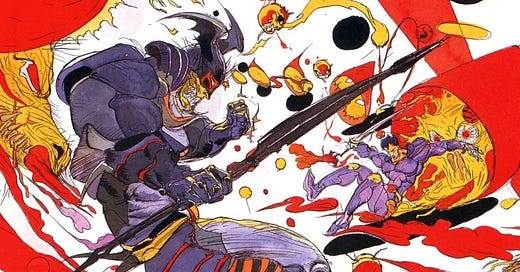Welcome to the Kupo Chronicle, the premium edition of the Wark Digest newsletter, where we explore the Final Fantasy universe in long-form and drill down into unique moments of the series’ history. I’m Chris, aka Hoogathy, and in this installment we’re investigating another interpretation of Final Fantasy’s earliest adventures. What does an anniversary tie-in product have to say about the larger stakes of Final Fantasy’s lore?
This week’s newsletter is 3879 words, a 18-minute read.
Adapting the Source
Video game adaptations have existed nearly as long as video games themselves, born partly of a desire to expand the razor-thin visuals of the earliest generations’ software. As we’ve previously explored in the Chronicle, Final Fantasy has been no exception to this—in Japan, anyway, where a manga was commissioned shortly after the original game’s release which took some… liberties with the source material.
But, of course, this was far from the last time Square would expand their flagship series into other mediums. Screen adaptations (ie. Advent Children, The Spirits Within, Kingsglaive, and the “other FFU,” Final Fantasy Unlimited) have taken the limelight, for better or worse. Meanwhile there is a relatively rich world of Final Fantasy literature—half manga, half novels—with a better track record overall, which doesn’t attract nearly as much attention as flashy CG feature films, even if it does also help bolster Square Enix’s financial reports.
As someone who became an avid reader out of a desire to consume the many tomes of expanded Star Wars adventures at my local library, I love that Final Fantasy has media tie-in novels of its very own. It feels like a sign of legitimacy, another thing that helps cement the series’ place in history—it’s right there on the shelf with titans of sci-fi, fantasy, and “geek culture” as Star Trek and Marvel, alongside other franchises with beloved stories like Mass Effect and Warcraft.
One such endeavor was commissioned as part of the 25th anniversary celebrations: a book titled Final Fantasy I-II-III: Memory of Heroes. As a retelling of the original three games, which had such scant and confined storylines in the first place, this project had a lot of potential to answer decades-old questions and add depth to worlds which players mostly experienced through empty, mute avatars.
So, at the precipice of its first quarter-century, how did Square choose to immortalize the franchise that had put it on the map?
Keep reading with a 7-day free trial
Subscribe to Wark Digest from Final Fantasy Union to keep reading this post and get 7 days of free access to the full post archives.





